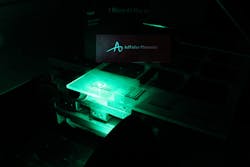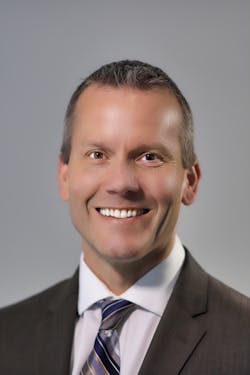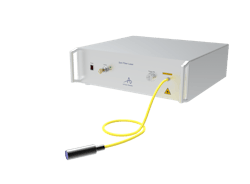Located in Tucson, AZ, AdValue Photonics is a manufacturer of innovative fiber lasers for materials processing, LIDAR, scientific, and medical markets. Founded in 2007, the company makes products such as fiber amplifiers, broadband fiber sources, and fiber-based components—all based on its fiber laser technology.
In this interview, Jose Pozo, Optica’s CTO, talks to CEO Michael Mielke about his career and AdValue Photonics.
Early career
Mielke started his career at the University of Florida (Gainesville, FL), where he studied physics. While in Gainesville, Mielke tried out several majors, but was “hooked” on physics after taking his first classical mechanics class. Following graduation, he decided to apply to the Center for Research and Education in Optics and Lasers (CREOL) at the University of Central Florida—fiber-optic telecommunications was a rapidly growing market in the late 1990s.
Mielke was accepted and quickly joined the research group of Peter Delfyett, professor of optics, electrical engineering, and physics at CREOL. While at CREOL, Mielke learned about high-speed photonics, telecommunications, and low-noise optical clocks.
During his final year at CREOL, Mielke attended and presented at his first OFC in 2003, which was a down year for the fiber optics industry. As a result, the mood at the Atlanta convention center was subdued and depressing. While not deterred from a career in telecommunications, Mielke went where there was opportunity. He finished his dissertation and joined a materials processing laser startup, Raydiance, an initiative from CREOL. The company founder, Jeff Bullington, was allocated funds from a Department of Defense (DoD)-type contract to build a new type of femtosecond laser for industry, medicine, and defense. The company used 1.5 µm erbium fiber systems to build the front end of the industrial laser, eventually creating the world’s first public software-controlled ultrasharp pulse.Startup experience
Mielke was at Raydiance for 11 years, from startup status to mature company. While the startup had a founding CEO, a CFO, and some faculty members from CREOL acting in an advisory capacity, Mielke was the first technical employee of the startup, where he served as chief scientist. He was tasked to work in the lab and develop the first prototype of the laser—an experience Mielke characterizes as daunting and fast-paced.
Despite the intense environment, Mielke learned a lot from his startup experience. He frequently briefed high-level DoD officials on the company’s progress. At first, Mielke felt like an imposter, fresh out of graduate school and he was being asked to share his expert opinion on ultrashort-pulse lasers to a room of top military technology leaders.
In his startup experience, Mielke made mistakes, learned quickly, and adapted to the fast pace. To him, the most rewarding aspect of being in a startup was hiring new talented employees and growing the company.
Next steps
After 11 years at Raydiance, Mielke worked for TRUMPF North America and Lumentum as program manager of microprocessing and director of engineering, respectively. After a few years, he traded the California sun for the brutal winters of Massachusetts and became CTO of Iradion Laser.
At Iradion, Mielke had the opportunity to work on CO2 lasers, a technology he had never worked on before. Fiber lasers have now largely replaced CO2 lasers at the many-kilowatt level for high-power metal cutting and welding applications. But at low- and medium-power applications, especially involving organic materials, CO2 lasers are still a reliable and effective technology. There is still innovation going on for CO2 laser technology, such as developing different waveguides and improving the efficiency and power of the RF-driven CO2 lasers.
After his time at Iradion, Mielke became Headwall Photonics’ vice president of engineering. This was a significant change for him—not only changing jobs during a global pandemic, but also switching from lasers to imaging. During this time, he and his team set up a hybrid work style to accommodate the need to work in the lab (testing drone-mounted imaging systems) and to mitigate the risk of contracting and spreading COVID-19.
The pandemic forced Mielke and his team to adapt to shifting and challenging supply chain circumstances, ultimately bringing the team closer together. In this position, he transitioned from lasers to spectral imaging, and learned about imaging technologies, sensor arrays, and unique optical engineering applications. He gained hands-on experience with the techniques used to make airborne platform spectrometers with excellent spatial resolution and scene capture.
New adventure
Mielke worked with AdValue Photonics at Raydiance, collaborating on a project for the National Science Foundation. At the time, Raydiance used an amplifier module from AdValue Photonics. Mielke built a professional rapport with the founder and CEO of AdValue Photonics, Shibin Jiang; in 2022, Jiang reached out to offer Mielke the CEO position. This offer came out of the blue for him while Headwall Photonics was being acquired in early 2022 by Arsenal Capital Partners. This was an opportunity that he couldn’t pass up.
AdValue Photonics
AdValue Photonics is known for its lasers, made on-site and delivered worldwide, and its vertically integrated supply chain. The company purchases raw chemicals, creates glass, and shapes it into fiber preforms, and then draws the preforms to make gain and passive fibers for novel lasers and amplifiers. These are then made into large mode-area short-path-length fiber amplifiers for short-pulse or single-frequency amplification.
Many fiber laser companies exist, but AdValue Photonics differentiates itself by specializing in the core technology that enables very high-power and high-energy generation of short-pulse and single-frequency lasers. These applications are typically limited by an optical nonlinearity, not a thermal effect. This directly depends on the path length, propagation length, and mode area inside the fiber amplifier.
AdValue Photonics’ core technology is its proprietary glass formula, created by the founder and his team years ago, based on rare earth ions (terbium and neodymium). In a typical silica fiber, an end-user is limited to a half percent by weight of the rare earth ion. If you go above that weight, you see clustering effects, where the proximity of ions to each other can lead to parasitic energy losses. An increased solubility means that the percent by weight of the rare earth ion can be increased without clustering effects occurring.
AdValue Photonics’ glass is fabricated to break up the long range of organization within the glass matrix, which prevents clustering effects. The outcome of this technology is a centimeters-long laser amplifier, which has a shorter path length. This allows the company to increase the core diameter and provide a larger mode field area, which expands the operating paradigm in short-pulse and single-frequency domains.
AdValue Photonics is also known for its 2 µm lasers and amplifiers. In 2007, when the company was founded, there weren’t many options for this kind of technology for researchers to purchase easily. Jiang saw this as an opportunity for the company to specialize. As soon as the first 2 µm lasers and amplifiers were made available, they were in very high demand. Mielke sees this technology being used for remote sensing and longer-distance LiDAR, and his vision for the future of these applications is to continue to provide robust, cost-effective platforms for emerging markets.While Mielke views the materials processing segment of AdValue Photonics as having the greatest potential for near-term growth, he understands the limitations of being a smaller company. AdValue Photonics is unable to compete with larger companies for a market share of this application, but can offer products that fit a specific niche.
Areas of growth for AdValue Photonics include providing solutions for selective material removal or material modification that require shorter wavelengths, as well as creating ultrashort-pulse lasers for customized markings, such as surface textures or patterns, which are permanent but don’t affect the mechanical functionality or long-term reliability of a part.
Biggest challenge for the company in the future?
Selling lasers to the medical industry is becoming increasingly difficult, especially for smaller companies. Mielke, however, is up for the challenge. His first contract at Raydiance was to develop a surgical laser. At the time, the DoD was looking for a laser to selectively remove dead tissue and foreign matter from the ligaments of injured soldiers. This requires a high-precision laser, as well as excellent imaging and software, to recognize tissue that needs to be removed. In response, the team developed a wound debridement laser.
Today, similar applications within the medical industry require techniques to mitigate the collateral effects of treatment. AdValue Photonics will need to overcome barriers to entry, such as the complete development and safety approval of their lasers, to enter the medical market. AdValue Photonics is a company poised for growth; since its founding, the company has had very positive success serving the scientific and research community. Looking forward, Mielke envisions the company entering new and emerging markets and experiencing a growth transition.
Words of wisdom for the younger generation?
Mielke’s advice to the younger generation, especially those with technical backgrounds, is to learn about organizational dynamics and how to function within a team. He recommends reading the works and research of Jeffrey Pfeffer of the Stanford Graduate School of Business. He also advises not to neglect elements of your life outside of work, such as exercise, mental health, or relationships, because these are the things that will sustain you through turbulent entrepreneurial periods or failed scientific endeavors.
Jose Pozo | Chief Technology Officer, Optica
Jose Pozo joined Optica in March 2022, and has spent more than 25 years working in photonics. He earned a PhD in quantum physics from the University of Bristol (U.K.), and an M.Sc. and B.Eng. in telecom engineering from UPNA, Spain / VUB (Belgium). Prior to joining the European Photonics Industry Consortium (EPIC) in 2015 as CTO, Jose was a Senior Photonics Technology Consultant with PNO Consultants, with some of the main accounts such as CERN, Thales, and TE Connectivity. He has worked at TNO, The Netherlands Organization for Applied Scientific Research, and as a postdoctoral researcher at the Eindhoven University of Technology in the Netherlands, where he contributed to the early development of EFFECT Photonics.
Ana Fowler | Market Research Analyst and Coordinator, Optica
Ana Fowler is market research analyst and coordinator at Optica (Washington, DC).


